Abstract
In this paper, we introduce some new types of extended Geraghty contractions, called -admissible generalized Geraghty F-contractions, and prove some fixed point results for such contractions in the setting of partial b-metric spaces. Moreover, based on the obtained fixed point results and the property of symmetry, we inaugurate a fixed point result for graphic generalized Geraghty F-contractions defined on partial metric spaces endowed with a directed graph. As an application, we examine the existence of a unique solution to the first-order periodic boundary value by the obtained fixed point result. Moreover, some examples are presented to illustrate the validity of the new results.
MSC:
Primary 47H10; Secondary 54H25
1. Introduction and Mathematical Preliminaries
Metric fixed point theory started with the prominent Banach Contraction Principle presented by Banach [1] in 1922. Due to its simplicity, usefulness and applications, it is widely used in many branches of mathematics and applied sciences. The “Banach Contraction Principle” states that, under certain conditions, a self-map T on a nonempty set X admits one or more fixed points. After that, numerous efforts have been done to generalize, improve or extend the Banach Contraction Principle. In those studies, two concerns have become the main focus of many scholars: an appropriate contraction condition and reasonable abstract metric spaces. A suitable contraction condition usually deals with many distances between various points, mainly involving the images through the operator T and its original images, such as , , , , , and so on. Meanwhile, an excellent contraction condition can also guarantee that the Picard iterative sequence converges to the fixed point of T for any initial point . One of the celebrated generalizations of the Banach Contraction Principle was the Geraghty-contraction given by Geraghty in [2] wherein the existence of a unique fixed point of such contractions controlled by a kind of auxiliary function was investigated in the setting of complete metric spaces. After Geraghty’s work, some authors have studied this theorem in several ways (see [3,4,5]). At the same time, the work of promoting the concept of standard metrics to various types of generalized metrics has not stopped yet. For instance, the b-metric was introduced by Bakhtin [6], which generalized the standard metric by modifying the triangular inequality condition with a real number . For further works and results in b-metric spaces, we refer to [7,8,9,10,11,12,13,14]. Moreover, another interesting generalization of the standard metric is the partial metric spaces introduced by Matthews [15], wherein self-distance of an arbitrary point need not be equal to zero. Combining the definitions of partial metric and b-metric, in 2014, Shukla [16] introduced the concept of partial b-metrics. Subsequently, Mustafa et al. [17] provided a modified version of partial b-metrics.
In 2012, Samet et al. [18] introduced the notion of -admissible mappings and obtained some fixed point results for such mappings. One year later, in 2013, Abdeljawad [19] defined a pair of -admissible mappings which are different from the ones in [18], and provided fixed point and common fixed point theorems. In 2013, Cho et al. [20] defined the concept of -Geraghty contraction type mappings and proved the existence of a unique fixed point for this kind of mappings in complete metric spaces. Afterward, an extension of -admissible mappings were presented by Chandok [21] by introducing -admissible mappings.
Most recently, Wardowski [22] introduced the concept of F-contraction and obtained a fixed point result as a generalization of Banach Contraction Principle. After that, several authors investigated the necessity of the conditions – and presented some weak conditions by replacing or removing some of them. For more details in this direction, we refer to [23,24,25,26,27].
Motivated by the above results, in this paper, a concept of -admissible generalized Geraghty F-contractions is introduced and some fixed point results concerning such contractions are established. In addition, some examples and applications are presented to illustrate our results. Our proposed definitions and related applications are different from those introduced in [28]. In the sequel, , , , and represent the set of all real numbers, positive real numbers, natural numbers, and positive integers, respectively. Some useful definitions and auxiliary results are listed in the following.
Definition 1
([29]). Let Ω be a nonempty set, be a given real number, and let ρ be a function from into . The pair is said to be a b-metric space if, for all x, y, , the following assumptions hold:
if and only if ;
;
.
The number is called the coefficient of .
Definition 2
([15]). A function is called a partial metric on a nonempty set Ω if, for all , the following assumptions hold:
if and only if
;
;
.
The pair is called a partial metric space.
Definition 3
([16]). A function is called a partial b-metric on a nonempty set Ω if, for all and a given real number , the following assumptions hold:
if and only if ;
;
;
.
The pair is called a partial b-metric space. The number is called the coefficient of .
According to these definitions of metric spaces mentioned above, we can obtain the relations stated as follows:
Later, Mustafa et al. [17] modified the definition of partial b-metric by replacing by for which each partial b-metric can generate a b-metric .
Definition 4
([17]). A function is called a partial b-metric if, for all x, y, and a given real number , the following conditions are satisfied:
if and only if ;
;
;
.
The pair is called a modified partial b-metric space. The number is called the coefficient of .
Example 1
([16]). Let , and a function from into be defined by
for all , and a constant . Then, is a partial b-metric space with the coefficient , but it is neither a b-metric nor a partial metric space.
Example 2
([16]). Let ϱ and ρ be a partial metric and a b-metric with the coefficient on a nonempty set Ω. Then, the function defined by for all is a partial b-metric on Ω with the coefficient s.
Example 3.
Let be a partial metric space and p be a real number with . Then, is a partial b-metric space with the coefficient , where is defined by .
Proposition 1
([17]). Every partial b-metric on a nonempty set Ω defines a b-metric , where
for all .
Definition 5
([17]). Let be a partial b-metric space. The sequence in Ω and u in Ω; then,
the sequence is said to be convergent in Ω to u if ;
the sequence is said to be -Cauchy if exists (and is finite);
is said to be -complete if every -Cauchy sequence in Ω -converges to a point u in Ω, that is,
Lemma 1
([17]). Let be a partial b-metric space and a sequence in Ω. Then,
is a -Cauchy if and only if is a b-Cauchy with the b-metric ;
is -complete if and only if is b-complete. Moreover,
if and only if
Definition 6
([18]). Let T be a self-mapping on X and be a function. We say that T is an α-admissible mapping if
Definition 7
([21]). Let Ω be a nonempty set, and α, . T is said to be an -admissible if and implies and , for all .
Definition 8.
Let be a partial b-metric space, and . We say T satisfies α-admissible property, if a sequence in Ω with and , then there exists a subsequence of such that for all .
Definition 9.
Let be a partial b-metric space, and . We say T satisfies an -admissible property, if a sequence in Ω with , and , then there exists a subsequence of such that and for all .
On the other hand, Wardowski [22] introduced the auxiliary functions as follows:
Let be a mapping satisfying:
is strictly increasing, that is, for , such that implies ;
for each sequence of positive numbers if and only if ;
there exists such that .
We denote the set of all functions satisfying – by .
In [23], Secelean et al. replaced the condition by an equivalent but a more simpler condition .
,
or, also by
, there exists a sequence of positive real numbers such that . Most recently, Piri et al. [25] used the following condition instead of .
is continuous on .
Denote the set of all functions satisfying , and by .
Next, we introduce some three families of functions stated as follows.
Let the function satisfy is non-decreasing; is continuous; . Denote the set of functions by .
Let the function satisfy that . Denote the set of the functions by .
Let the continuous function satisfy that, for all , , , if for , where , then there exists such that . Denote the set of the functions by .
2. Main Results
2.1. Fixed Point Results for -Admissible Generalized Geraghty -Contractions
Let us start this section by introducing the following definition.
Definition 10.
Let be a partial b-metric space and , . We say that T is an -admissible generalized Geraghty -contraction of type on a partial b-metric space Ω, if T is -admissible, and there exist , , and such that, for all and with ,
where
and is a constant.
Definition 11.
Let be a partial b-metric space and , . We say that T is an -admissible generalized Geraghty -contraction of type on a partial b-metric space Ω, if T is -admissible, and there exist , and such that, for all x, and with ,
where ,
.
Remark 1.
Obviously, for each , we have the following relation:
that is, each -admissible generalized Geraghty -contraction of type is an -admissible generalized Geraghty -contraction of type .
One of our main result of this paper is stated as follows.
Theorem 1.
Let be a complete partial b-metric space and T be a self mapping on X satisfying the following conditions:
T is -admissible;
there exists such that and ;
T is an -admissible generalized Geraghty -contraction of type on ;
T is continuous or T satisfies -admissible property.
Then, T has a fixed point with and converges to u.
Furthermore, if for all , with such that , and , , then T has a unique fixed point in Ω.
Proof.
Let such that and . Define a sequence in X by for all . If for any , then is a fixed point of T. Consequently, assume that for all . Since T is an -admissible mapping, it follows from condition that , .
By induction, we obtain for all .
Similarly, for all .
If , for all . From (3) and , we deduce that
which is a contradiction. Thus, it follows that
Again, from (3) and the definition of , we have
which gives
Hence, is a decreasing sequence of positive real numbers. Repeating use of (5), we have
Since , by taking the limit in (4) as , we obtain
Since , then . From and condition (), we have the following
Now, we will prove that is a -Cauchy sequence in X. From Lemma 1, we need to prove that is a b-Cauchy sequence in the b-metric space . Suppose that is not b-Cauchy. Then, there exists and sequences of integers , with , such that, for we have
By choosing to be the smallest positive integer exceeding for which (8) holds, we may assume that
Analogously, we deduce that
Since , due to inequality (1), we have
By repeating the above technique, one can easily arrive at
From (16) together with (17) and (18), we have
This implies that
which also yields
Utilizing the definition of and , we obtain
a contradiction. Thus, is a b-Cauchy sequence in the b-metric space , so it is a -Cauchy sequence in the partial -metric space . Since is b-complete, then the sequence converges to some point , that is, . Again, from Lemma 1,
On the other hand, from (7) and condition , , which yields that
Next, we will show that u is a fixed point of T.
Case 1. Suppose that T is continuous. Due to the continuity of T, we have
which shows that u is a fixed point of T.
Case 2. Suppose that T satisfies -admissible property.
Since T satisfies -admissible property, there exists a subsequence of such that and for all .
It follows from the inequality (1) by putting and that
where
Taking the limit as in , we have
By following the same arguments as mentioned above, we have
By taking limit in (20) and due to equalities (21), (22) and property of function, we have
From the definitions of and , the above inequalities imply that
Then, we have
This implies that , that is, . Therefore, u is a fixed point of T.
Suppose that v is another fixed point of T with . From (1), together with the additional assumption, we obtain that
where
Therefore, it follows from the definition of and the values of and that
which leads to a contradiction. Hence, , that is, . Thus, we conclude that T admits a unique fixed point. Next, we will prove that . If , then, from (1), we have
which is a contradiction. Thus, . This completes the proof of the theorem. □
Theorem 2.
Let be a complete partial b-metric space and a self mapping T defined on Ω satisfy the following conditions:
T is α-admissible;
there exists such that ;
T satisfies the following contractive condition:
there exist , and such that, for all and with ,
where ,
;
T is continuous or T satisfies -admissible property.
Then, T has a fixed point with and converges to u.
Furthermore, if for all , with such that , , then T has a unique fixed point in Ω.
Proof.
Define a mapping as
Then, the conclusion follows from Theorem 1. □
Next, the following example is presented to verify the validity of our result.
Example 4.
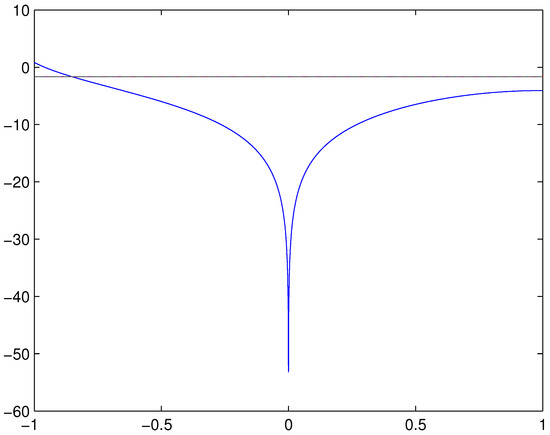
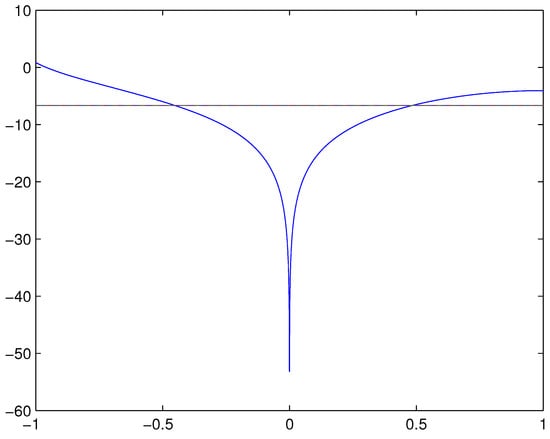
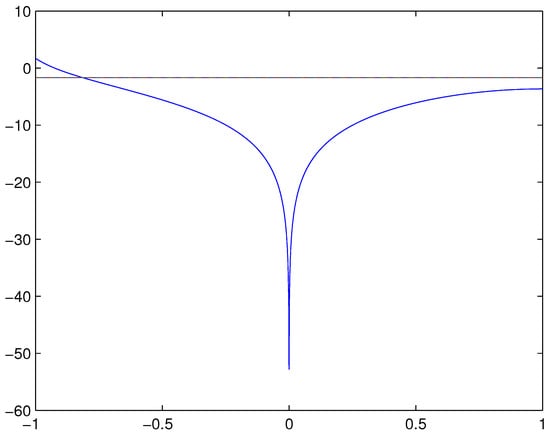
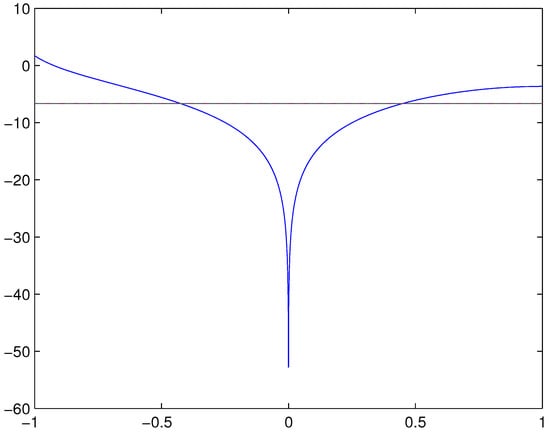
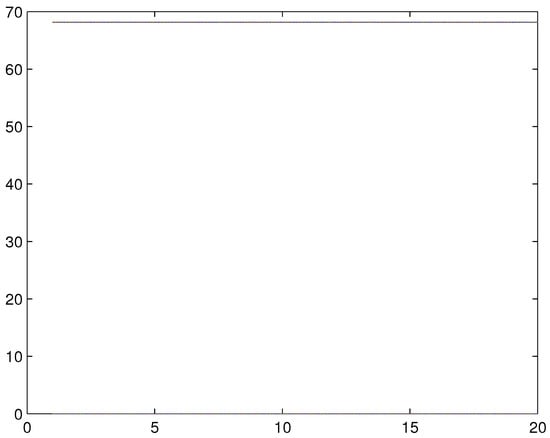
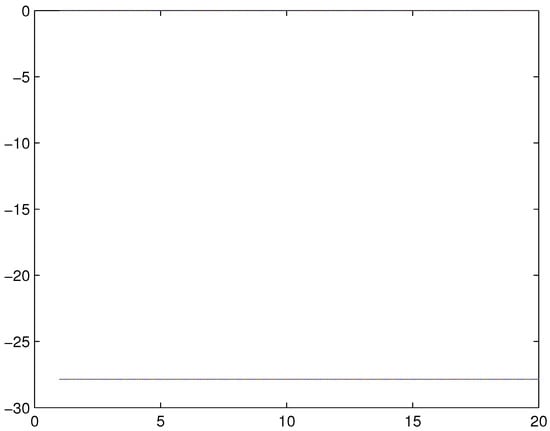
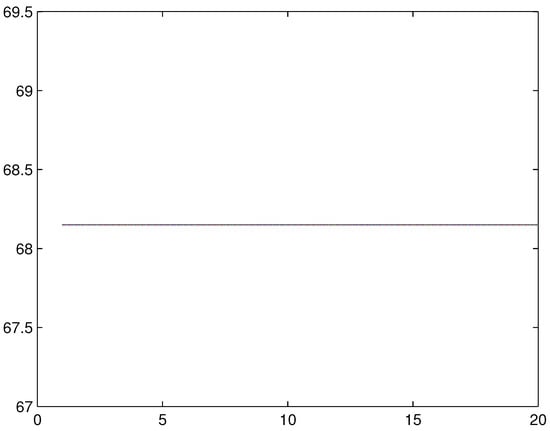
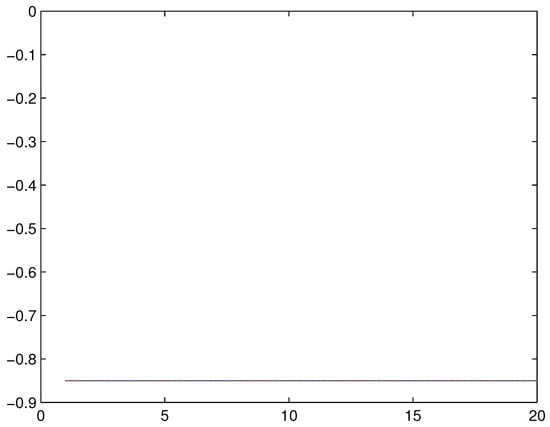
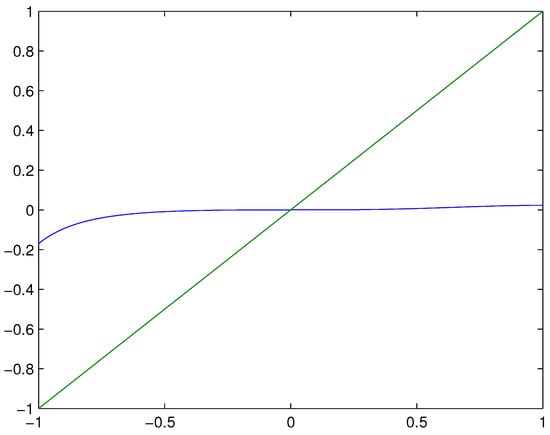
Let be equipped with the partial order relation ⪯ defined by
and the function is defined by
for all u, , where . It is obvious that is a complete partial b-metric space. Let the mapping is defined by
In addition, we define the mapping α, by
and
By the definition of T, it is clear that and . In addition, there exists in X such that and . Define by . In addition, let be given by . Let for all . Without loss of generality, we may take such that . In order to check the contractive condition of Theorem 1, we have to consider the following cases (briefly, the left-hand side is denoted by L.H.S, and the right-hand side is denoted by R.H.S):
Case I. If , then
For R.H.S., utilizing the definitions of , and , we have that
We verify that and , thus
for all and with . The following figures (see Figure 1, Figure 2, Figure 3 and Figure 4) demonstrate that R.H.S. expression (with black curve) and L.H.S. expression (with blue curve) for , which validates our inequality.

Figure 1.
Plot of inequality for Case I with in Example 4.

Figure 2.
Plot of inequality for Case I with and for condition (1) of Definition 10 in Example 4.

Figure 3.
Plot of inequality for Case I with in Example 4.

Figure 4.
Plot of inequality for Case I with or and for condition (1) of Definition 10 in Example 4.
Comparing with Definition 11, setting , in condition (1), and Figure 2 shows that the condition (1) of Definition 10 is not satisfied.
If we take , we can plot the figure below, and the R.H.S. expression (with black curve) dominates the L.H.S. expression (with blue curve) for :
Comparing with Definition 10, setting , in condition (1), Figure 4 shows that the condition (1) of Definition 10 is not satisfied.
Case II. If , then . From (1), we have
The figures below (see Figure 5 and Figure 6) show that R.H.S. expression (with black curve) overshadows the L.H.S. expression (not appearing in the figure, since it is ), which authenticates our inequality. Obviously, the whole figure is above the line . In this case, the figure of is the same as that of , since L.H.S. are both 0, R.H.S are both .

Figure 5.
Plot of inequality for Case II with and in Example 4.

Figure 6.
Plot of inequality for Case I with or and for condition (1) of Definition 10 in Example 4.
Comparing with Definition 10, setting or , in condition (1), L.H.S , R.H.S , so condition (1) in Definition 10 is not satisfied.
Case III. If and , then Case III is similar to Case II,
The figures below (see Figure 7 and Figure 8) show that R.H.S. expression (with black curve) overshadows the L.H.S. expression (not appearing in the figure, since it is ), which authenticates our inequality. Obviously, the whole figure is above the line . In this case, the figure of is the same as that of , since L.H.S. are both 0, and R.H.S are both .

Figure 7.
Plot of inequality for Case III with and in Example 4.

Figure 8.
Plot of inequality for Case I with or and for condition (1) of Definition 10 in Example 4.
Comparing with Definition 10, setting or , in condition (1), L.H.S , R.H.S , so condition (1) in Definition 10 is not satisfied.
Thus, all the conditions of Theorem 1 are fulfilled and is a unique fixed point of the involved mapping T (see Figure 9).

Figure 9.
The fixed point of the mapping T in Example 4.
Next, we present a fixed point result for cyclic mappings in partial b-metric spaces in the following theorem.
Theorem 3.
Let be a complete partial b-metric spaces with , and be two nonempty closed subsets of Ω. Let and are two mappings with , . Suppose that if , when . Furthermore, assume that T satisfies the following assumption for all
where ,.
If there exists such that and either T is continuous or T satisfies α-admissible property, then T has a fixed point u in and converges to u.
Furthermore, if for all , with such that , and , , then T has a unique fixed point in Ω.
Proof.
Let and be defined as .
It is obvious that is complete. Suppose that there exists with , from the definition of , we also have . Hence, the hypotheses (1)–(3) of Theorem 1 hold with . Afterward, suppose that is a sequence in X satisfying and for and . Hence, and . Since B is closed, then and and . We conclude that the hypothesis of Theorem 1 holds for . Consequently, T has a unique fixed point in , say u. Since implies that and implies , then . □
2.2. Fixed Point Results for Graphic -Admissible Generalized Geraghty F-Contractions
In this subsection, we present a fixed point result for graphic -admissible generalized Geraghty F-contractions in the setting of partial metric spaces endowed with a directed graph.
Consistent with Jachymisk [30], let be a partial space and . Let be a directed graph, where stands for the set of vertices which coincides with and the set of edges contains all loops, that is, . Assume that G has no parallel edges. The graph G can be converted to a weighted graph by assigning to each edge a weight equal to the distance between its vertices. If x and y are vertices in a graph G, then a path in G from x to y of length is a sequence of vertices such that and . A graph G is said to be connected if there exists a path between any two vertices. Recently, several results have appeared concerning sufficient conditions for a certain contractive mapping to admit a fixed point in the underlying space endowed with a graph. The first result in this direction was initiated by Jachymski [30].
Definition 12
([30]). Let be a partial metric space endowed with a graph G and T be a self-mapping defined on Ω. We say T is a G-contraction if T preserves edge of G, that is, for all ,
and T decreases weights of edges of G in the following way: there exists such that, for all ,
Definition 13
([30]). Let be a partial metric space endowed with a graph G and T be a self-mapping defined on Ω. We say T is a G-continuous if, for any and a sequence with as , for all implies as .
Definition 14.
Let be a connected graph with . We say graph G is said to satisfy the property , if a connected T-Picard sequence converges to u in Ω implies that there exists such that or for all .
Definition 15.
Let be a partial metric space endowed with a graph G and T be a self-mapping defined on Ω. We say T is a graphic generalized Geraghty -contractions, if there exist , and such that, for all and with ,
where ,
.
Theorem 4.
Let be a complete partial metric space endowed with a graph G and T be a self-mapping defined on Ω satisfying the following conditions:
T preserves the edge of G;
there exists such that ;
T is G-continuous or G satisfies property ;
T is a graphic generalized Geraghty -contractions.
Proof.
Define a mapping as
Now, we show that T is an -admissible mapping. Suppose that . Therefore, we have . From condition , we have . Thus, and T is an -admissible mapping. Hence, from the definitions of and graphic generalized Geraghty F-contractions, we have
where , .
Due to condition , there exists such that and .
Suppose that is a sequence in such that as and for all . Thus, from condition , we have that T is continuous or T satisfies an -admissible property.
Therefore, all conditions of Theorem 2 hold true and T has a fixed point. □
Now, we present an example to support Theorem 4 as follows.
Example 5.
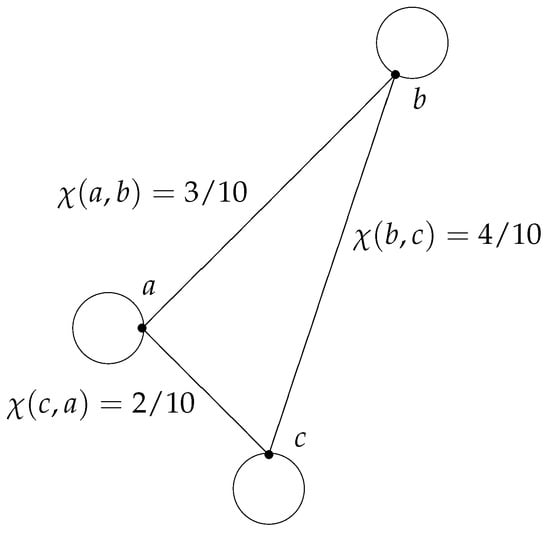
Let be endowed with the function defined by
It is easy to check that χ is a partial metric.
Define a function by . Now, define a mapping by
In addition, define two functions and by , for all and , for all .
Suppose that G is a direct graph such that and . It is easy to show that T preserves edges in G and T is G-continuous. Moreover, there exists such that . Without loss of generality, let with .
Next, we will show that condition in Theorem 4 holds. Consider the following cases:
Case I. If , then we have
Case II. If , then we have
Case III. If , then we have
Figure 10 represents the graph with all the possible cases. Therefore, all the conditions of Theorem 4 are satisfied and a is a fixed point of T.

Figure 10.
The graph G defined in Example 5.
3. An Application to the First Order Periodic Boundary Value Problem
In this section, we will examine the solution of the following first order periodic boundary value problem:
where is a continuous function for , and be any real number such that . Then, the following integral equation is equivalent to the preceding problem:
where is a Green’s function, defined by
Let be a set of all real valued continuous functions on and be defined by
for all . Obviously, is a complete partial b-metric space. Define the map by
Then, is a solution of (27) if and only if it is a fixed point of f.
Theorem 5.
Assume there exist real numbers such that , then, for any ,
where . Then, the differential equation (26) has a solution.
Proof.
Observe that is a complete partial b-metric space defined in (29)).
For , we have that
which yields
or
This implies that
where .
Since is increasing, we have that
Taking , we have that
Putting , together with , we can deduce that , where
In addition, by letting , we claim that .
From the fact of -admissibility, we obtain that
Hence, all the conditions of Theorem 1 are satisfied which implies that f has a fixed point, that is, the integral Equation (27) has a solution. □
4. Conclusions and Future Work
In this paper, we generalized Geraghty contractions by introducing -admissible generalized Geraghty F-contractions and establishing the corresponding fixed point theorem in partial b-metric spaces. In addition, we extended our main result to a class of graphic generalized contractions called graphic generalized Geraghty F-contractions. An application to a first order periodic boundary value problem was presented. On the other hand, there are a lot of studies on the non-unique fixed points (or called fixed figure) in the literature (for example, see [31] and the references therein). Let be a metric space, T be a self-mapping of X, and be the fixed point set of T. A circle/disc contained in the set is called the fixed-circle/fixed-disc of T (for more details, see [32,33]). At this point, some future directions of our study appear as the following:
Exploring the concept of -admissible generalized Geraghty F-contractions,
- (1)
- some new fixed figure results for such contractions can be investigated;
- (2)
- some new common fixed point (resp. coincidence point) results can be examined for the cases where the set is not a singleton.
Author Contributions
Conceptualization, M.W., X.L., A.H.A. and M.Z.; formal analysis, M.W., X.L., N.S. and M.Z.; investigation, M.Z., X.L. and A.H.A.; writing—original draft preparation, M.W., N.S., A.H.A. and M.Z.; writing—review and editing, M.W. and M.Z. All authors have read and agreed to the published version of the manuscript.
Funding
Min Wang is partially supported by the scientific research start-up project of Mianyang Teachers’ College (QD2019A08). Xiao-lan Liu is partially supported by the National Natural Science Foundation of China (Grant No. 11872043), Central Government Funds of Guiding Local Scientific and Technological Development for Sichuan Province (Grant No. 2021ZYD0017), Zigong Science and Technology Program (Grant No. 2020YGJC03), the Opening Project of Key Laboratory of Higher Education of Sichuan Province for Enterprise Informationalization and Internet of Things (Grant No. 2020WYJ01), 2020 Graduate Innovation Project of Sichuan University of Science and Engineering (Grant No. y2020078), 2021 Innovation and Entrepreneurship Training Program for College Students of Sichuan University of Science and Engineering (Grant No. cx2021150).
Institutional Review Board Statement
Not applicable.
Informed Consent Statement
Not applicable.
Data Availability Statement
No data were used to support this study.
Conflicts of Interest
The authors declare that they have no competing interest.
References
- Banach, S. Sur les oprationes dans les ensembles abstraits et leur application aux quation integrales. Fund. Math. 1922, 3, 133–138. [Google Scholar] [CrossRef]
- Geraghty, M. On contractive mappings. Proc. Am. Math. Soc. 1973, 40, 604–608. [Google Scholar] [CrossRef]
- Gordji, M.E.; Ramezani, M.; Cho, Y.J.; Pirbavafa, S. A generalization of Geraghtys theorem in partially ordered metric spaces and applications to ordinary differential equations. Fixed Point Theory Appl. 2012, 2012, 74. [Google Scholar] [CrossRef][Green Version]
- Martinez-Moreno, J.; Sintunavarat, W.; Cho, Y.J. Common fixed point theorems for Geraghtys type contraction mappings using the monotone property with two metrics. Fixed Point Theory Appl. 2015, 2015, 174. [Google Scholar] [CrossRef][Green Version]
- Mongkolkehai, C.; Cho, Y.J.; Kumam, P. Best proximity points for Geraghtys proximal contraction mappings. Fixed Point Theory Appl. 2013, 2013, 180. [Google Scholar] [CrossRef]
- Bakhtin, I.A. The contraction mapping principle in quasi metric spaces. Funct. Anal. Gos. Ped. Inst. Ulianowsk 1989, 30, 26–37. [Google Scholar]
- Aghajani, A.; Abbas, M.; Roshan, J.R. Common fixed point of generalized weak contractive mappings in partially ordered b-metric spaces. Math. Slovaca 2014, 64, 941–960. [Google Scholar] [CrossRef]
- Aleksić, S.; Huang, H.; Mitrović, Z.; Radenović, S. Remarks on some fixed point results in b-metric space. J. Fixed Point Theory Appl. 2018, 20, 147. [Google Scholar] [CrossRef]
- Faraji, H.; Nourouzi, K.; O’Regan, D. A fixed point theorem in uniform spaces generated by a family of b-pseudometrics. Fixed Point Theory 2019, 20, 177–183. [Google Scholar] [CrossRef]
- Hussain, N.; Mitrović, Z.D.; Radenović, S. A common fixed point theorem of Fisher in b-metric spaces. Rev. R. Acad. Cienc. Exactas Fís. Nat. Ser. A Math. 2019, 113, 949–956. [Google Scholar] [CrossRef]
- Miculsecu, R.; Mihail, A. New fixed point theorems for set-valued contractions in b-metric spaces. J. Fixed Point Theory Appl. 2017, 19, 2153–2163. [Google Scholar] [CrossRef]
- Mitrović, Z.D. A note on the results of Suzuki, Miculescu and Mihail. J. Fixed Point Theory Appl. 2019, 21, 24. [Google Scholar] [CrossRef]
- Zoto, K.; Rhoades, B.; Radenović, S. Common fixed point theorems for a class of (s, q)-contractive mappings in b-metric-like spaces and applications to integral equations. Math. Slovaca 2019, 69, 233–247. [Google Scholar] [CrossRef]
- Mitrović, Z.D.; Hussain, N. On weak quasicontractions in b-metric spaces. Publ. Math. Debrecen 2019, 94, 29. [Google Scholar] [CrossRef]
- Matthews, S.G. Partial metric topology, in Proceeding of the 8th summer conference on General Topology and Application. Ann. N. Y. Acad. Sci. 1994, 728, 183–197. [Google Scholar] [CrossRef]
- Shukla, S. Partial b-metric spaces and fixed point theorems. Mediterr. J. Math. 2014, 11, 703–711. [Google Scholar] [CrossRef]
- Mustafa, Z.; Roshan, J.R.; Parvanesh, V.; Kadelburg, Z. Some common fixed point results in ordered partial b-metric spaces. J. Inequal. Appl. 2014, 1, 562. [Google Scholar] [CrossRef]
- Samet, B.; Vetro, C.; Vetro, P. Fixed point theorems for α- ψ-contractive type mappings. Nonlinear Anal. 2012, 75, 2154–2165. [Google Scholar] [CrossRef]
- Abdeljawad, T. Meir-Keeler α-contractive fixed and common fixed point theorems. Fixed Point Theory Appl. 2013, 2013, 19. [Google Scholar] [CrossRef]
- Cho, S.H.; Bae, J.S.; Karapinar, E. Fixed point theorems for α-Geraghty contraction type maps in metric spaces. Fixed Point Theory Appl. 2013, 2013, 329. [Google Scholar] [CrossRef]
- Chandok, S. Some fixed point theorems for (α,β)-admissible geraghty type contractive mappings and related results. Math. Sci. 2015, 9, 127–135. [Google Scholar] [CrossRef]
- Wardowski, D. Fixed points of a new type of contractive mappings in complete metric spaces. Fixed Point Theory Appl. 2012, 1, 94. [Google Scholar] [CrossRef]
- Secelean, N.A. Iterated function system consisting of F-contractions. Fixed Point Theory Appl. 2013, 1, 277. [Google Scholar] [CrossRef]
- Secelean, N.A.; Wardowski, D. ψF-contractions: Not necessarily nonexspansive Picard operators. Results Math. 2016, 70, 415–431. [Google Scholar] [CrossRef]
- Piri, H.; Kumam, P. Some fixed point theorems concerning F-contraction in complete metric spaces. Fixed Point Theory Appl. 2014, 1, 210. [Google Scholar] [CrossRef]
- Lukács, A.; Kajxaxntó, S. Fixed point results for various type F-contractions in complete b-metric spaces. Fixed Point Theory 2018, 19, 321–334. [Google Scholar] [CrossRef]
- Alsulami, H.H.; Karapinar, E.; Piri, H. Fixed points of generalized F-Suzuki type contraction in complete b-metric spaces. Discrete Dyn. Nat. Soc. 2015, 2015, 969726. [Google Scholar] [CrossRef]
- Abbas, M.; Ali, B.; Vetro, C. Fuzzy fixed points of generalized F2-Geraghty type fuzzy mappings and complementary results. Nonlinear Anal. Model. Control 2016, 21, 274–292. [Google Scholar] [CrossRef]
- Czerwik, S. Contraction mappings in b-metric spaces. Acta Math. Inform. Univ. Ostrav. 1993, 1, 5–11. [Google Scholar]
- Jachymski, J. Equivalent conditions for generalized contractions on (ordered) metric spaces. Nonlinear Anal. 2011, 74, 768–774. [Google Scholar] [CrossRef]
- Karapinar, E. Recent Advances on the Results for Nonunique Fixed in Various Spaces. Axioms 2019, 8, 72. [Google Scholar] [CrossRef]
- Özgür, N.Y.; Taş, N. Some fixed-circle theorems and discontinuity at fixed circle. AIP Conf. Proc. 2018, 1926, 020048. [Google Scholar]
- Özgür, N.Y.; Taş, N. Some fixed-circle theorems on metric spaces. Bull. Malays. Math. Sci. Soc. 2019, 42, 1433–1449. [Google Scholar] [CrossRef]
Publisher’s Note: MDPI stays neutral with regard to jurisdictional claims in published maps and institutional affiliations. |
© 2022 by the authors. Licensee MDPI, Basel, Switzerland. This article is an open access article distributed under the terms and conditions of the Creative Commons Attribution (CC BY) license (https://creativecommons.org/licenses/by/4.0/).